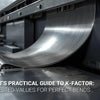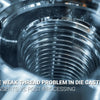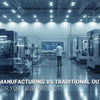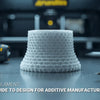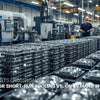Die Casting Applications: Key Industries and Uses
Die Casting Applications
Die casting is a versatile manufacturing process used in various industries due to its ability to produce complex shapes with high precision, strength, and excellent surface finishes. Let’s explore some of the key applications where die-casting plays a pivotal role:
1. Automotive Industry
The automotive industry is one of the largest consumers of die-cast components. Die casting is ideal for producing lightweight, durable, and high-performance parts that are essential for modern vehicles.
- Engine Components: Die casting is widely used for making engine components like cylinder heads, engine blocks, and valve covers. These parts need to withstand high temperatures and pressures, and die casting provides the required strength and heat resistance.
- Transmission Parts: Components such as transmission cases and housings are die-cast to ensure precision and durability. The accuracy of die-cast parts is crucial for the smooth operation of transmission systems.
- Structural Parts: Lightweight structural parts, including shock towers, suspension components, and steering systems, are often die-cast from aluminum to reduce the overall weight of vehicles without compromising strength.
2. Aerospace Industry
In the aerospace industry, die casting is utilized to manufacture components that need to be both lightweight and strong, meeting strict regulatory and safety standards.
- Aircraft Frames and Components: Die-cast parts are used in aircraft frames, landing gear, and other critical components where weight savings and strength are essential.
- Engine Components: Die-casting helps produce precise and durable engine components that can withstand extreme temperatures and stresses encountered during flight.
3. Electronics Industry
Die casting is extensively used in the electronics industry to produce components that require precise dimensions and excellent thermal conductivity.
- Enclosures and Housings: Die-cast aluminum is commonly used for electronic device enclosures and housings, providing both durability and efficient heat dissipation.
- Heat Sinks: Die-cast aluminum heat sinks are popular in electronic devices due to their ability to efficiently dissipate heat, protecting sensitive components from overheating.
4. Consumer Goods and Appliances
Die casting is widely used in the manufacturing of consumer goods and appliances, where aesthetic appeal and durability are crucial.
- Kitchen Appliances: Die-cast components are found in kitchen appliances like blenders, toasters, and coffee machines. The process allows for the creation of stylish, durable parts with a smooth finish.
- Hardware and Tools: Items such as door handles, locks, and various hand tools are often made through die casting to provide strength and a premium feel.
5. Telecommunications
In telecommunications, die casting is used to create components that require precision and durability, essential for reliable communication networks.
- Antenna Components: Die-cast parts are used in the production of antennas and other communication devices, where precision and strength are vital.
- Enclosures: Die-cast aluminum enclosures protect delicate telecommunications equipment from environmental factors while providing efficient heat management.
6. Industrial Machinery and Equipment
Die casting is also employed in the production of parts for industrial machinery and equipment, where robustness and longevity are paramount.
- Pumps and Valves: Die-cast components are used in pumps, valves, and other industrial equipment that require durable, corrosion-resistant parts.
- Heavy Machinery: Die-cast parts are utilized in heavy machinery for construction, mining, and other industrial applications, providing the necessary strength and durability for demanding environments.
7. Medical Devices
The medical industry relies on die casting to produce components that require high precision and durability, ensuring patient safety and device reliability.
- Medical Equipment: Die casting is used in the manufacturing of medical devices and equipment like imaging machines, surgical tools, and other critical healthcare equipment.
- Orthopedic Devices: Die-cast components are found in orthopedic devices and implants that require high precision and biocompatibility.
8. Home Improvement and Decor
Die casting is also popular in the home improvement and decor industry for producing aesthetically pleasing, durable items.
- Decorative Hardware: Items like curtain rods, brackets, and decorative knobs are often made using die casting to achieve intricate designs and high-quality finishes.
- Lighting Fixtures: Die-cast aluminum is used in lighting fixtures and chandeliers, providing strength and an elegant appearance.
9. Toy Manufacturing
Die casting is used in the toy industry to produce small, detailed, and durable components, especially in metal toy cars and action figures.
- Model Cars and Toys: Die-cast metal is ideal for creating detailed model cars, airplanes, and other toys that require a sturdy, realistic finish.
10. Renewable Energy
In the renewable energy sector, die casting contributes to the production of components for wind turbines, solar panels, and other green technologies.
- Wind Turbine Components: Die-cast parts are used in wind turbines to ensure strength and durability, essential for long-term operation in harsh environments.
- Solar Panel Frames: Die-cast aluminum frames provide the necessary support and protection for solar panels while being lightweight and corrosion-resistant.
Conclusion
Die casting is a highly versatile manufacturing process that serves a broad range of industries, from automotive to aerospace, electronics, and beyond. Its ability to produce high-quality, durable, and precise components makes it an invaluable technology in today’s manufacturing landscape. With continuous advancements in die-casting technology and materials, we can expect even more innovative applications in the future.
FAQs
-
Why is die casting preferred for automotive parts?
- Die casting is preferred for automotive parts because it produces lightweight, durable, and precise components, which are essential for vehicle performance and fuel efficiency.
-
Can die casting be used for ferrous metals?
- No, die casting is typically used for non-ferrous metals like aluminum, zinc, and magnesium due to their lower melting points and good casting properties.
-
What makes die casting ideal for electronic enclosures?
- Die casting is ideal for electronic enclosures because it provides precise dimensions, excellent thermal conductivity, and effective protection against electromagnetic interference (EMI).
-
How does die-casting benefit the medical device industry?
- Die casting benefits the medical device industry by producing high-precision, durable components that ensure device reliability and patient safety.
-
Are die-cast parts recyclable?
- Yes, die-cast parts are recyclable. Metals like aluminum and zinc can be recycled without losing their properties, making die casting an environmentally friendly manufacturing process.

